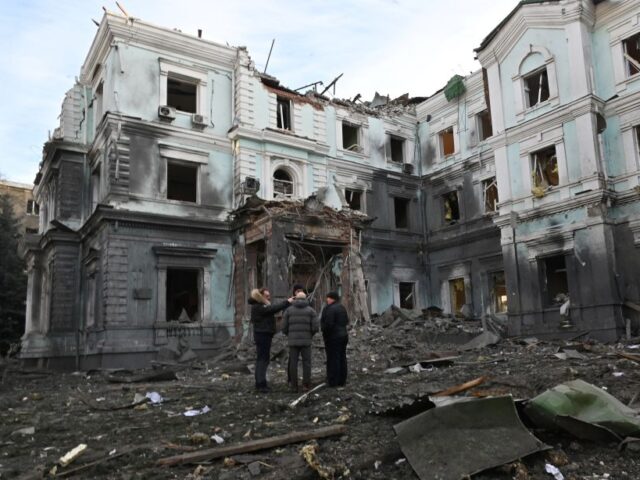A top NATO general warns the lessons of the Ukraine War shows Europe its interior and cities cannot expect to be left untouched if Russia and the Alliance fight.
“Rear areas will be severely contested” in an attempt to “destroy lines of communication” in the case of a war between Russia and NATO, a top general from the alliance states, while warning the ability of NATO to credibly deter aggression has been erroded since the end of the Cold War.
Lieutenant General Alexander Sollfrank, speaking to The Times of London pointed to the Ukrainian experience in defending itself against the renewed Russian invasion, where cities far from the front line — and as far away from Russia as settlements on the border with NATO member states Poland and Romania — are regularly attacked. The Ukrainians have replied in kind, and frequently launch raids against Russian cities and infrastructure within Russia itself, sometimes hundereds of miles beyond the frontline.
The General’s remarks come amid a flurry of statements, expressing by turns both urgency and reassurance, from top leaders in the NATO structure.
NATO: Next 20 Years Not ‘Hunky Dory’ and Public Needs to Prepare Itself to Survive ‘The First 36 Hours’ of War https://t.co/B3V11pExOs
— Breitbart London (@BreitbartLondon) January 19, 2024
On the potential threat to European cities, which The Times noted were likely German, given its position in central Europe and certain matters of history make its military bases the axle around which the NATO’s spokes radiate, General Sollfrank said the risk reflected the Ukraine experience. He told the publication:
“If we compare war and operations ten years ago or five years ago, then we realise that we have to accept that also the rear areas will be severely contested…
“We have to assume that an aggressor will use the whole spectrum of kinetic and non-kinetic force in order to destroy lines of communication, also in the rear area. That ranges from acts of sabotage through electronic warfare and cyber to kinetic possibilities through missiles, drones and so on.”
The report also cited the remarks of U.S. Brigadier General Ronald Ragin who said it would be shameful for Europe to not prepare for its cities being “contested”, saying in the case of a conflict, “the enemy” would naturally attempt hybrid warfare against the staging areas of NATO troops in the deep hinterland before they had a chance to reach the front lines.
He said: “We as a coalition have to think through: how do we operate in that environment? How do we operate when our convoys are contested? How do we operate when our railways are interdicted?”
Another issue facing European defence, Lieutenant General Alexander Sollfrank — the head of NATO’s Joint Support and Enabling Command, the body responsible for coordinating renforcing NATO forces in wartime — said was how the defence support network had been weakened in the 30 years of peace since the end of the Cold War. “Tanks, ammunition… infrastructure… depots, we had the infrastructure to store ammunition” but much of this had been “destroyed… disbanded or torn down” as surplus to requirement since, he said.
‘Russian’ GPS Jamming Again Impacts Poland and Baltic, Sweden Military Intelligence Investigating https://t.co/eATnlmTl4w
— Breitbart London (@BreitbartLondon) January 18, 2024
Now NATO is having to work “very hard on creating this robust, resilient reinforcement and sustainment network” to replace it and “the roads, the railways, the depots, the prepositioning of stocks” would all have to become part of that, and consequiently become “resilient infrastructure” to function in wartime — in other words so they can’t be easily destroyed by drone strike or saboteur.
“We have no time to waste”, said the General.
General Sollfrank’s remarks come amid a flurry of other top NATO leaders expressing their feelings on the how the present Ukraine situation may or may not overflow into a general war in Europe with Russia. Appearing to concur with his position is Admiral Rob Bauer, the most senior military officer in NATO, who said this month that European society had to prepare itself for war and that should conflict come it would not be a remote, out-of-sight incident dealt with by professional soldiers, but rather a “whole of society event” with civillian participation, as is the case in Ukraine.
In his bleak assesment, the top officer said: “What hasn’t happened is in our societies, the understanding that it is more than the military that has to be able to operate in a conflict or in a war. It is the whole of a society that will get involved whether we like it or not… the people, they have to understand they play a role. Society is part of the solution… you need to have water, you need to have a radio on batteries, you need to have a flashlight with batteries to make sure you can survive the first 36 hours. Things like that, that’s simple things but it starts there.”
Pouring cool water on this alarming take, is the head of NATO itself, Secretary General Jens Stoltenberg, who said last week there is no “direct or imminent” threat to NATO nations. The statement had been in response to a question asking about the likelihood of “Russian tanks” rolling into European cities within the coming decade.
NATO is about to begin exercise Steadfast Defender 24, the largest wargames for the Alliance since the end of the Cold War. Per their own figures, 90,000 troops are due to take part, as well as over 1,100 tanks and fighting vehicles, 80 aircraft, and 50 ships and submarines.
The Next Pearl Harbor or 9/11 Could Be Brought by a Drone https://t.co/ByWYLGGG4i via @BreitbartNews
— James P. Pinkerton (@JamesPPinkerton) January 30, 2024

COMMENTS
Please let us know if you're having issues with commenting.